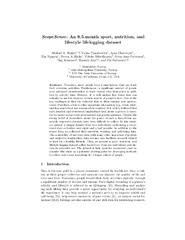Browsing Artikler, rapporter og annet (informatikk) by Author "Thambawita, Vajira"
-
HyperKvasir, a comprehensive multi-class image and video dataset for gastrointestinal endoscopy
Borgli, Hanna; Thambawita, Vajira; Smedsrud, Pia H; Hicks, Steven; Jha, Debesh; Eskeland, Sigrun Losada; Randel, Kristin Ranheim; Pogorelov, Konstantin; Lux, Mathias; Dang Nguyen, Duc Tien; Johansen, Dag; Griwodz, Carsten; Stensland, Håkon Kvale; Garcia-Ceja, Enrique; Schmidt, Peter T; Hammer, Hugo Lewi; Riegler, Michael; Halvorsen, Pål; de Lange, Thomas (Journal article; Tidsskriftartikkel; Peer reviewed, 2020-08-28)Artificial intelligence is currently a hot topic in medicine. However, medical data is often sparse and hard to obtain due to legal restrictions and lack of medical personnel for the cumbersome and tedious process to manually label training data. These constraints make it difficult to develop systems for automatic analysis, like detecting disease or other lesions. In this respect, this article ... -
Meta-learning with implicit gradients in a few-shot setting for medical image segmentation
Khadka, Rabindra; Jha, Debesh; Riegler, Michael A.; Hicks, Steven; Thambawita, Vajira; Ali, Sharib; Halvorsen, Pål (Journal article; Tidsskriftartikkel; Peer reviewed, 2022-01-12)Widely used traditional supervised deep learning methods require a large number of training samples but often fail to generalize on unseen datasets. Therefore, a more general application of any trained model is quite limited for medical imaging for clinical practice. Using separately trained models for each unique lesion category or a unique patient population will require sufficiently large curated ... -
ScopeSense: An 8.5-Month Sport, Nutrition, and Lifestyle Lifelogging Dataset
Riegler, Michael Alexander; Thambawita, Vajira; Chatterjee, Ayan; Nguyen, Thu; Hicks, Steven; Telle-Hansen, Vibeke; Pettersen, Svein Arne; Johansen, Dag; Jain, Ramesh; Halvorsen, Pål (Chapter; Bokkapittel, 2023-03-29)Nowadays, most people have a smartphone that can track their everyday activities. Furthermore, a significant number of people wear advanced smartwatches to track several vital biomarkers in addition to activity data. However, it is still unclear how these data can actually be used to improve certain aspects of people’s lives. One of the key challenges is that the collected data is often massive and ...


 English
English norsk
norsk

